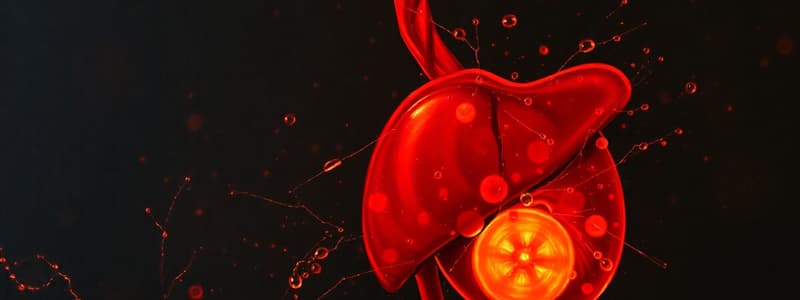Podcast
Questions and Answers
What is the principal pigment found in bile?
What is the principal pigment found in bile?
- Bilirubin (correct)
- Urobilinogen
- Cholesterol
- Myoglobin
What percentage of bilirubin produced daily originates from hemoglobin breakdown?
What percentage of bilirubin produced daily originates from hemoglobin breakdown?
- 85% (correct)
- 65%
- 50%
- 80%
At what plasma bilirubin concentration is jaundice clinically evident?
At what plasma bilirubin concentration is jaundice clinically evident?
- > 35 μmol/L
- > 70 μmol/L
- > 25 μmol/L
- > 50 μmol/L (correct)
Which form of bilirubin is primarily measured in serum tests?
Which form of bilirubin is primarily measured in serum tests?
What condition leads to pre-hepatic jaundice as a result of increased bilirubin levels?
What condition leads to pre-hepatic jaundice as a result of increased bilirubin levels?
What is the daily production range of bilirubin in the body?
What is the daily production range of bilirubin in the body?
What is a potential hepatic cause of increased bilirubin levels in blood?
What is a potential hepatic cause of increased bilirubin levels in blood?
Which of the following tests is NOT associated with evaluating jaundice?
Which of the following tests is NOT associated with evaluating jaundice?
What is the primary method of bilirubin excretion from the body?
What is the primary method of bilirubin excretion from the body?
Which of the following proteins can contribute to bilirubin production when degraded?
Which of the following proteins can contribute to bilirubin production when degraded?
Which condition is characterized by a deficiency or suppression of UDP transferase activity?
Which condition is characterized by a deficiency or suppression of UDP transferase activity?
What type of jaundice is caused by post-hepatic factors, such as bile duct obstruction?
What type of jaundice is caused by post-hepatic factors, such as bile duct obstruction?
In the case of raised plasma bilirubin with normal liver enzymes, which condition can be ruled out?
In the case of raised plasma bilirubin with normal liver enzymes, which condition can be ruled out?
Gilbert’s disease is associated with what type of bilirubin transport disturbance?
Gilbert’s disease is associated with what type of bilirubin transport disturbance?
Which bilirubin fraction is elevated in cases of liver disease when total bilirubin is raised?
Which bilirubin fraction is elevated in cases of liver disease when total bilirubin is raised?
What is the reference range for total bilirubin in adults in mg/dl?
What is the reference range for total bilirubin in adults in mg/dl?
Crigler-Najjar syndrome involves a defect in which enzyme?
Crigler-Najjar syndrome involves a defect in which enzyme?
Where does bilirubin primarily originate from?
Where does bilirubin primarily originate from?
Which type of bilirubin is excreted via the bile duct and is water-soluble?
Which type of bilirubin is excreted via the bile duct and is water-soluble?
Which condition is specifically identified by the post-conjugation failure of bilirubin transport?
Which condition is specifically identified by the post-conjugation failure of bilirubin transport?
Flashcards
What is bilirubin?
What is bilirubin?
A breakdown product of hemoglobin, a major component of red blood cells.
Where does bilirubin come from?
Where does bilirubin come from?
Bilirubin is produced when aged red blood cells are broken down by the reticuloendothelial system.
What does the liver do with bilirubin?
What does the liver do with bilirubin?
The liver synthesizes bile, which contains bile acids and bilirubin.
What is the process of bilirubin metabolism?
What is the process of bilirubin metabolism?
Signup and view all the flashcards
What are the two forms of bilirubin?
What are the two forms of bilirubin?
Signup and view all the flashcards
Which form of bilirubin is most common in the blood?
Which form of bilirubin is most common in the blood?
Signup and view all the flashcards
What is jaundice?
What is jaundice?
Signup and view all the flashcards
What causes increased bilirubin levels?
What causes increased bilirubin levels?
Signup and view all the flashcards
What is hemolytic jaundice?
What is hemolytic jaundice?
Signup and view all the flashcards
What tests can help diagnose jaundice?
What tests can help diagnose jaundice?
Signup and view all the flashcards
Jaundice
Jaundice
Signup and view all the flashcards
Hepatic Jaundice
Hepatic Jaundice
Signup and view all the flashcards
Conjugation Failure
Conjugation Failure
Signup and view all the flashcards
Neonatal Jaundice
Neonatal Jaundice
Signup and view all the flashcards
Crigler-Najjar Syndrome
Crigler-Najjar Syndrome
Signup and view all the flashcards
Bilirubin Transport Disturbances
Bilirubin Transport Disturbances
Signup and view all the flashcards
Gilbert's Disease
Gilbert's Disease
Signup and view all the flashcards
Dubin-Johnson Syndrome
Dubin-Johnson Syndrome
Signup and view all the flashcards
Obstructive Jaundice
Obstructive Jaundice
Signup and view all the flashcards
Elevated Bilirubin with Normal Liver Enzymes
Elevated Bilirubin with Normal Liver Enzymes
Signup and view all the flashcards
Study Notes
Liver Function Tests: Plasma Bilirubin
- Bilirubin is a breakdown product of haemoglobin, a component of red blood cells.
- The liver synthesizes bile, containing bile acids (derived from cholesterol) and bilirubin.
- Bilirubin is the principal pigment in bile.
- Approximately 85% of daily bilirubin is formed from the breakdown of haemoglobin.
- The remaining bilirubin comes from erythrocyte precursors and the breakdown of haem-containing proteins (like myoglobin, cytochromes, and catalase).
- Aged red blood cells are phagocytosed by the reticuloendothelial system, releasing haemoglobin, which is broken down into bilirubin.
- Normal serum bilirubin levels range from 0.2-1.0 mg/dL (3-17 µmol/L).
- Only a small proportion (around 0.2 mg/dL, or 1/5th of the total) is in conjugated form.
- The majority of bilirubin (~90%) is excreted in the faeces as urobilinogen, which is converted to stercobilin. A small amount (about ~10%) is filtered by the kidney and excreted in the urine.
Bilirubin Metabolism
- Bilirubin, initially unconjugated, is transported in the blood bound to albumin.
- In the liver, unconjugated bilirubin is taken up by hepatocytes.
- Inside the hepatocytes, the bilirubin is conjugated to glucuronic acid, making it water-soluble.
- Conjugated bilirubin is secreted into the bile canaliculi, then transported to the small intestine.
- In the small intestine, bacteria metabolize conjugated bilirubin to urobilinogen.
- A portion of urobilinogen is reabsorbed into the portal circulation and returned to the liver.
- Most urobilinogen is eliminated in the faeces as stercobilin.
Clinical Significance
- Elevated plasma bilirubin levels (>50 µmol/L) can lead to jaundice.
- Jaundice is characterized by yellowish pigmentation of the sclera (whites of the eyes) and skin.
- Elevated bilirubin levels are caused by an imbalance between bilirubin production and removal.
- Causes of increased bilirubin include haemolysis, ineffective erythropoiesis, liver dysfunction, and biliary obstruction.
Interpretation of Elevated Bilirubin Levels
- Elevated bilirubin levels with elevated liver enzymes suggest liver disease or biliary obstruction.
- Elevated bilirubin with normal liver enzymes may indicate conditions like haemolysis, Gilbert's syndrome, or Crigler-Najjar syndrome.
Bilirubin Summary
- Bilirubin originates from red blood cell breakdown and certain haemoglobin-containing proteins.
- It's primarily transported bound to albumin, most in unconjugated form, unable to pass through filter membranes.
- In the liver, bilirubin is conjugated, becoming water-soluble and able to be excreted via bile duct.
- In the small intestine, it's metabolized by bacteria to urobilinogen, then to stercobilin, mainly excreted in faeces.
Reference Ranges (Adult)
- Total bilirubin: 0.2-1.0 mg/dL (3-17 µmol/L)
- Unconjugated bilirubin: 0.2-0.8 mg/dL (3-14 µmol/L)
- Conjugated bilirubin: 0-0.2 mg/dL (0-3 µmol/L)
Reference Ranges (Infant)
- Reference ranges for total bilirubin are provided in mg/dL (specific ranges vary by age, and if premature or full-term).
Types of Jaundice
- Haemolytic: Pre-hepatic. Caused by increased red blood cell destruction.
- Hepatic: Hepatocellular. Caused by liver dysfunction.
- Obstructive: Post-hepatic. Caused by bile duct blockage.
Familial Causes of Raised Bilirubin
- Gilbert's syndrome: Reduced bilirubin uptake by liver cells.
- Crigler-Najjar syndrome: Impaired bilirubin conjugation.
- Dubin-Johnson syndrome: Defective secretion of conjugated bilirubin.
Studying That Suits You
Use AI to generate personalized quizzes and flashcards to suit your learning preferences.



